article and photographs by Richard Carleton Hacker
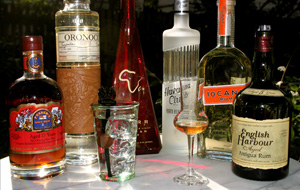
Six top New Age rums (l. to r.) Pusser’s wood-distilled 15 Year Old Navy Rum; triple-distilled Oronoco from Brazil - each of the leather-wrapped bottles is stamped with the date of distillation; Starr from the volcanic island of Mauritius in Africa; Havana Club, made from the original recipe by Bacardi; 10 Cane from Trinidad; and English Harbour 5 Year Old from Antigua. |
Captain Jack Sparrow might have been "the world's best pirate" in his quest for the dead man's chest, but he definitely would have been out of his league had he tried to chug a flagon of rum while straddling the yardarm. The image of rum is changing from those days of "Yo Ho Ho." In fact, you can forget about all those pedestrian cocktails such as the Cuba Libre, where Coca-Cola was used to disguise the taste of less-than-palatable rum, for this is a new age and there is a new wave of rums lapping up upon our shores, and they are destined to be sipped straight, or at the very least, used in only the most finely crafted Mojitos and Daiquiris prepared by skilled mixologist in the hippest of cocktail lounges.
That's a long, centuries-old voyage for a spirited drink that can literally trace its roots to the growing of sugar cane in China. Being a versatile and prolific crop, sugar cane was soon planted in other countries as well, including Africa, South America, and most notably the Caribbean. Human nature being what it is, someone soon discovered the residue from crushed cane stalks could be fermented. The result was Demon Rum, or "kill devil," as it was first called, in the belief that it could ward off evil. Pre-dating bourbon, rum became the national drink of the American colonies, where it was distilled and consumed with equal enthusiasm. Although distillation has largely moved to other countries, rum is once again being discovered in America, which consumed 21.8 million cases of rum in 2005 – slightly more than a fifth of the world's total demand.
Today, most distillers classify rums as light, gold, and dark. Distillation is either done in large quantity column stills, such as those used by Bacardi – one of the world's leading rum producers – or in smaller, handcrafted pot stills. Generally speaking, column stills produce a lighter tasting rum, while pot stills result in a heavier taste. While white (or clear) rums are aged in steel tanks or uncharred oak barrels to preserve their clarity, dark rums are the result of leaving in (and sometimes adding) the amber colored caramel and molasses that is a by-product of the burnt sugar cane. In addition, extra aging, especially in charred oak barrels, deepens the color of rum and produces a greater depth of taste. Like Cognac, rum is a composition of blends carefully orchestrated to give each of the hundreds of brands a distinctive character.
Some prime examples of rum's individuality and its soaring appeal to both bartenders and consumers can be found in one of the hottest rum bars in London, a rollicking hangout called Trailer Happiness located on Portobello Road in Notting Hill (trailerh.com). This is rum mecca, with its own Rum Club that boasts 200 members, each of whom have a personal Tiki God mug displayed on a shelf on the far wall. The first Monday of each month, club members meet at Trailer Happiness and attempt to drink their way through over 36 rums on display at the backbar. Here you'll find rums that you may not encounter anywhere else, like Cruzan 80 proof Black Strap, with its heavy taste of thick licorice and burnt molasses. Cruzan also offers a rare 100 proof Clipper rum, consisting of their very best rums that have been aged for a minimum of two years in charred oak casks; its rose gold color bespeaks of delicate floral accents soaked in lemon. Or Cuba's San Cristôbal de la Habana – no, not the cigar, but the Havana Club Añejo Solera rum. You'll also spot bottles holding dark rums from J. Bally and Saint James, both from Martinique, and a rare ceramic ship's decanter containing navy strength Pusser's rum.
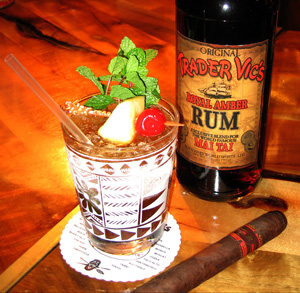
The original Trader Vic’s Mai Tai, as made by Beverly Hills head bartender Ben Chung. |
If you decide to go the cocktail route, bartender Chris March can mix you up an aptly named Atomic Punch, a blend of Havana Club Añejo Blanco and Appleton V/X rums shaken with peach, mango, and passion fruit and topped with champagne. They also make a mean Mai Tai with a 151 Overproof J. Wray & Nephew rum "floater," one of the best versions of the Mai Tai I've had outside of Trader Vic's itself.
But indeed, there is nothing like going directly to the source – Trader Vic's itself - for the classic "Polynesian" drink, which was actually invented in Oakland, California in 1944 by "Trader" Vic Bergeron and Frank Lui, his head bartender.
"We talked about creating…the finest drink we could make, using the finest ingredients we could find," the late Bergeron recounted in his book, Frankly Speaking: Trader Vic's Own Story (Doubleday & Company; 1973).
What they came up with was this:
2 ounces 17-year-old J. Wray & Nephew Jamaican rum
1/2 ounce French Garnier Orgeat
1/2 ounce Holland DeKuyper Orange Curaçao
1/4 ounce Rock Candy Syrup
Juice from one fresh lime
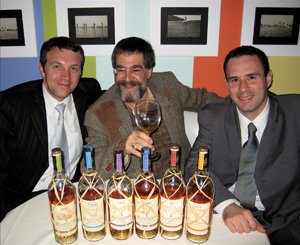
Stephane Defot, West Coast Regional Director for Cognac Ferrand (l.) with the author (c.) and Fabien Levieux, master distiller for Plantation Rums, test the six currently available offerings. Notice the Bordeaux glasses used for the tasting, which provide a greater area for nosing the aromas. |
"We poured the ingredients over shaved ice in a double old-fashioned glass," Bergeron wrote, "shook it well, added one spent lime shell and garnished it with a sprig of fresh mint."
Just as he was about to taste it, a waiter told Bergeron that two of his friends, Eastham and Carrie Guild from Tahiti, were at the restaurant. Bergeron went out to greet them.
"I told them I had just made a new drink that I hadn't even tasted yet," he recalled, "and would they like to try it with me? ‘Sure' they said, and so I had two more made up using the exact same formula as the first. The drinks arrived. I tasted mine and didn't say a thing. Carrie and Ham tasted theirs and Carrie asked Ham, ‘What do you think of it?'
"‘It's mai tai, he said, ‘It's mai tai roa áe'"
"I asked what in the hell that meant and Ham said, ‘In Tahitian it means out of this world, the best.'"
"That's the name of this drink, then," I said. "It's Mai Tai. It's out of this world."
The popularity of the drink soon depleted the world's supply of the 17-year-old rum and the recipe was altered accordingly. Today, The Original Mai Tai is created to perfection by Ben Chung, Trader Vic's head bartender in Beverly Hills. Here is their official recipe:
3/4 oz. fresh lime juice
3/4 ounce Leroux Orange Curaçao
3/4 ounce Trader Vic's Orgeat Almond syrup
1 ounce Coruba dark Jamaican rum
1 ounce dark Lemon Hart & Son Rhum Demerara from Guyana.
On occasion, I have seen Trader Vic's dark rum substituted for one of the other brands. Although Trader Vic's is famous for their more than 70 exotic rum cocktails, such as the Samoan Fog Cutter and the Scorpion, their double-rum Mai Tai remains the worldwide chain's most popular drink. I have often seen Ben make seven at once with carefully choreographed skill. And as if the Mai Tai was not potent enough, there is a special high octane version he will make with Lemon Hart & Son 151 proof rum if you ask for it.
"We don't advertise that one," cautions Chai Rojana, who began working with Bergeron in 1978 and is now General Manager of the Beverly Hills Trader Vic's. "And we are very careful who we serve it to. Only people who know us well order it."
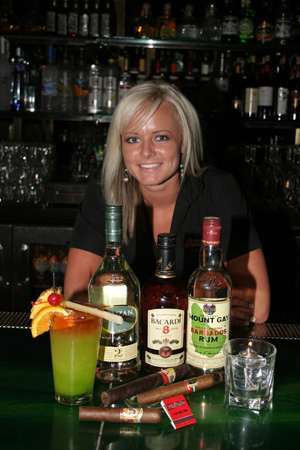
At Mandalay Bay’s rumjungle in Las Vegas, bartender Heather Humphries assembles the ingredients for their colorful rumjunglejuice, one of their most popular – and cigar friendly - cocktails. |
Another destination for run lovers is Mandalay Bay's rumjungle in Las Vegas. This cavernous enclave is ablaze with burning Tiki poles and alive with the pounding of drums, all of which sets the mood to field test 150 to 175 rums (depending on supply and the world situation) displayed behind the bar in the middle of the room. Indeed, aside from the forbidden Cuban rums (cigars aren't the only things affected by the embargo) there are few rums you cannot find here, from Pyrat's limited Cask 23 with its cognac-like qualities of caramel and vanilla, to the thick, meaty pot and still blended Sea Wynde, and Santa Teresa 1796 from Venezuela, which uses the Solera system combined with French oak barrels and comes closest in taste to a Cuban rum without actually being one.
But there are newer rums coming on the market that are worth the time to search out. One of the most unique is Pusser's new 15 Year Old Navy Rum, a double gold medal winner in the San Francisco Spirits contest – of which I am one of the judges – and which has rightfully been hailed as "the single malts of rum." Not only has this rum been aged in wood, it has been distilled in wood – centuries old wooden Admiralty pot stills. There are only two such ancient pot stills left in the world, and both are dedicated to producing Pusser's 15 Year Old rum. Consequently, Pusser's is unique in its delicate lemony-molasses flavors dusted with musty toasted oak and a hint of cinnamon. It is a complex rum, made even rarer by the fact that after 15 years of aging only 7% remains in the barrel. The rest has been lost to evaporation. Thus it takes about 16 bottles of rum to produce a single bottle of Pusser's 15 Year Old. It should just about be reaching America by the time you read this.
Another gold medal winner at the recent San Francisco World Spirits Competition is English Harbour 5 Year Old Rum from Antigua. Made in traditional copper pot stills in a distillery that dates from 1932, its sweet, delicate floral flavor can be attributed to the special old-fashioned baker's yeast used to ferment the charred molasses, and the fact that Antigua has an exceptionally dry climate, which accelerates maturation, giving this 5-year-old elixir the character of a much older rum.
Of course, many rums do not put their years of aging on the label, as some are blends of different distillations from different years, much like Cognacs. But a few Cognacs are vintage dated, most of which are from Cognac Ferrand and thus, it comes as no surprise that their Plantation rums are also vintage dated.
"We want consumers to look at vintage rums like they would vintage wines," said Stephane Defot, West Coast Regional Director for Cognac Ferrand. "With Plantation rums, each bottle has a single geographic origin, a single vintage, and consequently, a single character."
Cognac Ferrand's Plantation collection of rums include Plantation Rum Trinidad 1993, Plantation Rum Barbados 1995, Plantation Nicaragua 1998, and the oldest, Plantation Rum Guyana 1990. A Plantation Granada 1998 and St Lucia 2001 will be released in 2007. Only their Venezuela 1992 is not vintage dated, as it is a blend of different 8 year old rums from different years. There is also a new 1997 rum from Panama just becoming available for the first time.
Not only do Plantation rums spotlight the differences a vintage can make, they also dramatically showcase the specific taste characteristics of each country or island where the rums are distilled. For example, Barbados is a volcanic island, and the 1995 Barbados Plantation rum is distinctively light with flavors of apples, pears, and dried apricots. Jamaica uses a longer, three day fermentation in pot stills with retorts, which results in a spicy, wood-like undercurrent. The Plantation 1997 rum from Panama, on the other hand, is lighter in texture with a sweet, candied hint of marzipan and lemon, which comes from the fact that both column stills and pot stills are used for the rums in its final blend. And Plantation Rum Trinidad 1993, one of the rarest because of its lack of availability, is also one of the lightest tasting. Unlike many other rums, which are either 80 or 86 proof, all Plantation rums clock in at 90 proof.
"We believe that rum, in order to have flavor, needs to be a certain proof to have that aromatic richness and power that can only come
with a sufficient level of alcohol," said Fabien Levieux, master distiller of Cognac Ferrand. "Of course, we're not drinking (rum) just to get drunk. One enjoys rum for the beauty of it, for the aromatic richness, to experience the finish, to determine how many flavors can you actually find in a single glass of rum."
Consequently, not all of the new rums are lingering on The Dark Side. One of the most exciting new white rums is the reappearance of Havana Club, Cuba's "outlawed" rum that has not been allowed in the United States since the embargo. But last January, Bacardi - which had been producing Havana Club in Cuba until Castro's take-over - won their court case to market the rum in the U.S. (Meanwhile, the Cuban government has been distilling Havana Club in Cuba's Santa Cruz del Norte from a non-original recipe since the 1960s).
The original white (clear) Havana Club rum is being re-created in Bacardi's Puerto Rican distillery from the original recipe, thanks to the cooperation of Ramón Arechavala, a member of the family that has owned Havana Club since the 1930s. Its complex smoky liquorice and oak undertones have been captured in a classic 1930s-styled bottle that will start appearing on shelves early in 2007. It is complex and elegant enough to be sipped neat - no ice. Or it can, of course, be used in cocktails like the Mojito, or for something a simple as a splash of soda with fresh lime.
Another great white rum is 10 Cane from Trinidad, made from sugar cane rather than from molasses, that has been grown specifically for white rum. Traditionally, the stalks are harvested in groups of ten, hence the name. The cane juice goes through a small batch distillation in French pot stills and is then aged in uncharred French oak barrels, which gives it an elegance laced with a natural vanilla essence from the oak. It makes a great Mojito, or can simply be enjoyed on the rocks.
Also relatively new in the white rum scene is Oronoco, a pot-still spirit from Brazil that boasts a gold medal from the San Francisco World Spirits Competition. Mountain-grown sugar cane is crushed right after harvesting, and the fresh, unprocessed juice is triple-distilled and then blended with other soft-tasting, aged South American rums and pure Brazilian spring water. The rum is then gently "finished" in Brazilian Amendoim wooden casks which lend a slight hint of vanilla.
Equally distinctive, in both packaging and taste, is Starr African Rum, made on the volcanic African island of Mauritius. Indeed, its hints of cardamom and citrus – two ingredients found in many gins – give it a taste as unique as its red pyramid-shaped bottle, and points out why, after hundred of years, rum has finally come of age.
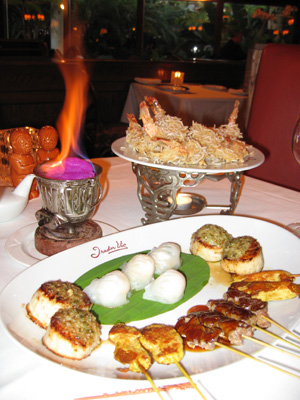
Good rum deserves good food, as evidenced by these Trader Vic’s Pupu’s at the Beverly Hills restaurant. |
|
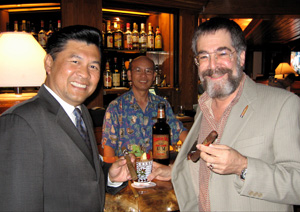
Chai Rojana (l.), General Manager of the Beverly Hills Trader Vic's, and Ben Chung (c.), Trader Vic’s head bartender, with the author (r.) as he gets ready to enjoy a Mai Tai and savor a cigar afterwards (outside the world famous restaurant, thanks to Prop 10). |
|
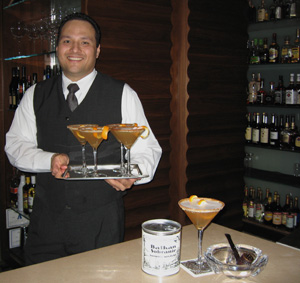
Bartender Ray Sandoval gets ready to serve a tray of Cable Car Martinis in Michael Mina’s Nob Hill at MGM Grand in Las Vegas. The potent drinks are made with Captain Morgan Original Spiced Rum, Bacardi 151 proof rum, and a sugared cinnamon rim, all of which complement a bowlful of Balkan Sobranie in a gold-capped Dunhill pipe. |
|
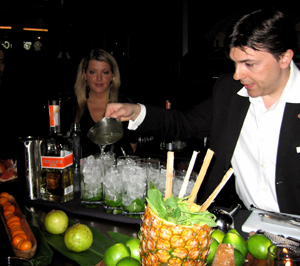
Francesco LaFranconi, expert mixologist for 10 Cane rum, prepares a batch of Mojitos, using 10 Cane rum, freshly squeezed lime juice, simple syrup, a splash of club soda, and 8 to 10 mint leaves. |
|
|